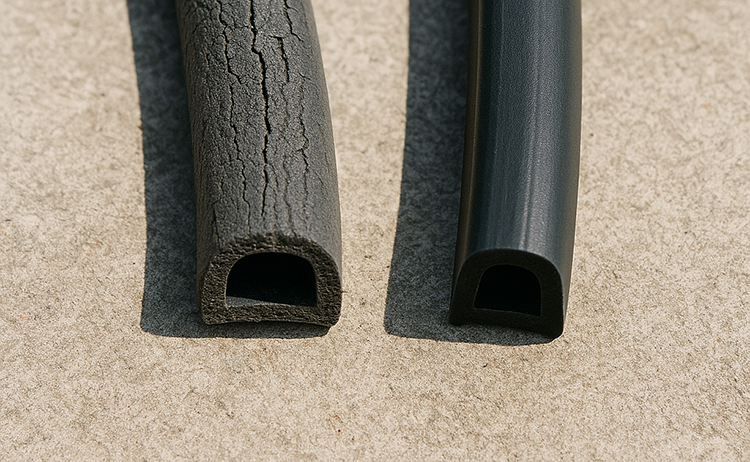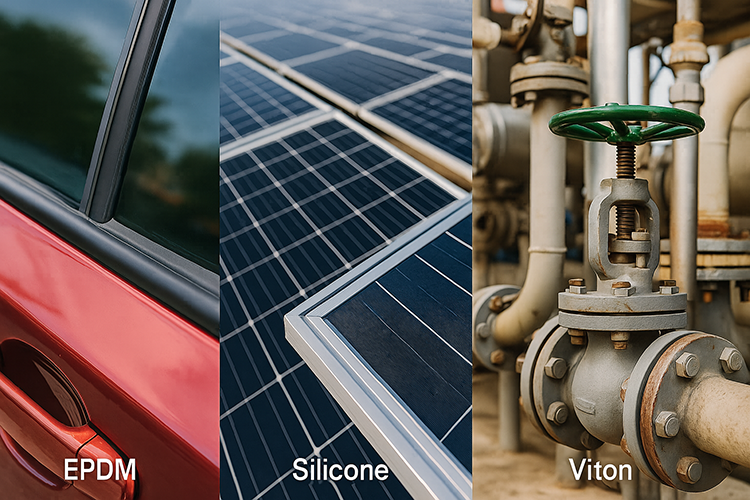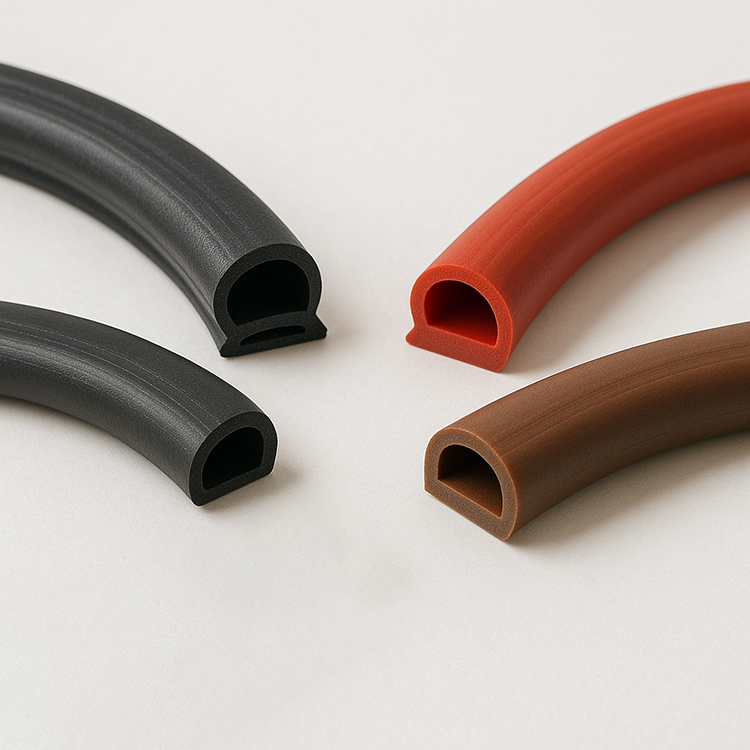Why UV Resistance Matters in Seal Materials
When I first started working with rubber seals, I underestimated the power of sunlight. But UV radiation, especially in outdoor or high-altitude settings, is a silent destroyer. Over time, it breaks down the chemical bonds in many rubber materials—causing cracking, chalking, color fading, and eventually failure. In industrial equipment, vehicles, and construction elements, a failed seal isn’t just a minor inconvenience—it can lead to water leaks, mechanical breakdowns, or costly safety risks.
I’ve seen perfectly engineered products ruined because the wrong seal material was used in a UV-intense environment. So if your application involves outdoor exposure—whether it’s a rooftop HVAC system, automotive door gasket, solar panel frame, or marine hatch—you need to pay close attention to the UV resistance of your sealing materials.

Here’s what you’ll get in this article: I’ll walk you through the top-performing UV-resistant rubber options, compare their strengths in a practical table, and help you understand which one fits your specific use case. This will save you from premature seal failure, minimize maintenance costs, and improve your product’s reliability.
Let’s dive into the materials that actually last under the sun.
Best UV-Resistant Seal Materials
Not all rubbers are created equal—especially when exposed to the sun. I’ve worked with a wide range of materials, but only a few consistently deliver strong UV resistance over time. If you want seals that won’t crack, harden, or lose elasticity after months or years outdoors, here are your top contenders:
1. EPDM (Ethylene Propylene Diene Monomer)
This is my go-to for most outdoor sealing applications. EPDM has excellent resistance to UV rays, ozone, and general weathering. It’s widely used in automotive door seals, window gaskets, and roofing applications.
2. Silicone Rubber
Silicone offers unmatched performance in extreme temperatures—from freezing cold to blazing heat—and it holds up exceptionally well under prolonged UV exposure. It’s a smart choice for applications where both heat and sunlight are concerns, like lighting enclosures or solar power systems.
3. Viton (FKM)
If the environment is chemically aggressive and UV-exposed, Viton is a premium solution. It resists UV, ozone, and a wide array of fluids. Aerospace and high-performance automotive industries rely on it for a reason.
4. Neoprene (CR)
Neoprene is moderately UV-resistant. It’s not as durable as EPDM or silicone in long-term exposure, but it holds up better than natural rubber and is often used in marine and outdoor equipment.
5. Other Materials
Materials like nitrile (NBR), natural rubber, and some TPEs are not suitable for UV-exposed sealing applications. They degrade quickly and become brittle or sticky when exposed to sunlight.
Here’s a simplified comparison table I often share with my clients:
| Material | UV Resistance | Temperature Range (°C) | Chemical Resistance | Flexibility | Typical Use Cases |
|---|---|---|---|---|---|
| EPDM | Excellent | -50 to +130 | Good | High | Car doors, windows, roofs |
| Silicone | Excellent | -60 to +230 | Moderate | Very High | Electronics, lights, solar systems |
| Viton | Very Good | -20 to +200 | Excellent | Moderate | Aerospace, engines, fuel systems |
| Neoprene | Moderate | -40 to +120 | Moderate | Good | Marine, outdoor gear |
| NBR | Poor | -30 to +100 | Good (non-UV) | Good | Indoor fuel and oil systems only |
Bold takeaway: If your seals are going to see the sun, don’t take chances—choose EPDM, silicone, or Viton. They’ll cost more upfront, but you’ll save tenfold in maintenance and replacements.
Choosing the Right UV-Resistant Seal
When it comes to picking the right material for UV-resistant seals, it’s not just about choosing the one with the best performance on paper. Over the years, I’ve learned that application context is everything. To avoid over-engineering (or worse—under-specifying), you need to consider the following three key factors:
1. Exposure Duration
Will the seal be exposed to direct sunlight all day, or just a few hours a week? EPDM is ideal for long-term continuous outdoor exposure. Silicone performs better when there’s also extreme heat involved. If the exposure is minimal or seasonal, you might even get away with neoprene.
2. Chemical Compatibility
If your seal comes into contact with oils, fuels, or harsh chemicals, you’ll need to go beyond just UV protection. That’s where Viton truly shines—it handles both UV and aggressive fluids, making it indispensable in engines, chemical tanks, and refineries.
3. Temperature Range
UV exposure often comes with heat. If your seal is near engines, lighting systems, or solar panels, you must factor in thermal resistance. Silicone rubber is excellent in this regard—it stays flexible in both extreme cold and intense heat.
To make the decision easier, here’s a quick reference table I use when consulting for outdoor sealing projects:
| Application Type | Recommended Material | Reason |
|---|---|---|
| Rooftop or window gaskets | EPDM | Excellent UV and weather resistance, cost-effective |
| Outdoor lighting enclosures | Silicone | Withstands UV and heat, remains flexible over years |
| Automotive engine compartment | Viton | UV and chemical resistance in high-heat, oil-rich environments |
| Marine hatch or outdoor tools | Neoprene | Adequate UV performance with good resistance to water and wear |
| Fuel or oil handling (outdoors) | Viton | Superior fluid resistance + outdoor durability |
Quote to remember:
“UV resistance alone is not enough—always pair it with temperature and chemical performance for lasting results.”

Next, I’ll walk through the most frequently asked questions I get from buyers and engineers when selecting UV-resistant seal materials.
What is the best rubber for UV resistance?
When someone asks me, “What’s the best rubber for UV resistance?” my answer is almost always EPDM or silicone, depending on the application. Both of these elastomers have proven themselves across thousands of use cases. EPDM leads the pack for general outdoor use because it combines excellent weatherability, ozone resistance, and affordability. Silicone, on the other hand, is unbeatable in UV + high temperature situations—like solar panel gaskets, electronic enclosures, or high-altitude equipment.
Why not just use one material for everything? Because every application has trade-offs. EPDM doesn’t handle oils well, and silicone is more expensive and less tear-resistant. That’s why knowing your environment and performance requirements is key.
Runner-ups include:
- Viton (FKM): UV + chemical resistance, ideal for aerospace, fuel systems, and chemical plants.
- Neoprene (CR): Moderate UV resistance, better than many rubbers, but not for prolonged exposure.
Avoid materials like:
- NBR (Nitrile Rubber) and Natural Rubber – they degrade rapidly in sunlight, losing their elasticity and cracking within weeks or months outdoors.
In summary, EPDM is your best bet for general UV protection, while silicone is the go-to for UV in extreme conditions. When oil or fuel exposure is also a factor, Viton is worth the investment.
Is EPDM UV resistant?
Absolutely. EPDM is one of the most UV-resistant elastomers available today, and that’s why I recommend it so often for outdoor sealing needs. It’s engineered specifically to resist degradation from UV rays, ozone, and oxygen—factors that commonly lead to cracking and hardening in less durable materials.
I’ve seen EPDM seals used on rooftops, around windows, in solar panel frames, and even on car doors—performing well year after year. In fact, its resilience makes it a favorite in the construction and automotive industries, especially where cost-effectiveness matters.
Here’s what sets EPDM apart:
- Excellent UV and ozone resistance
- Wide operating temperature range (-50°C to +130°C)
- Resistant to steam, water, and polar solvents
- Long lifespan in outdoor environments
However, EPDM does have a limitation: it doesn’t handle oils or petroleum-based fluids well. So if your seal is exposed to grease, fuel, or hydraulic oils, you’ll want to look at alternatives like Viton.
If your application is all about resisting the sun, rain, and outdoor air—EPDM is likely the smartest and most economical choice.
How does silicone perform under UV exposure?
If I had to name the most UV-stable rubber across extreme conditions, I’d say silicone wins hands down. It’s not just resistant to UV radiation—it practically shrugs it off, even after years of exposure. I’ve worked with silicone seals installed on aircraft, solar panels, outdoor electronics, and high-intensity LED fixtures that remain intact, flexible, and reliable despite relentless sunlight and heat.
Here’s why silicone stands out:
- Resists UV-induced cracking, chalking, and discoloration
- Maintains flexibility from -60°C to +230°C
- Unaffected by ozone and dry air aging
- Color-stable—great for visible gaskets or transparent components
What makes it truly exceptional is that silicone doesn’t just survive harsh UV—it stays elastic, which is critical for maintaining an airtight or watertight seal.
That said, silicone isn’t perfect. It tends to be:
- More expensive than EPDM
- Mechanically weaker in tear and abrasion resistance
- Sensitive to certain oils and fuels
Still, for applications that combine UV, ozone, and temperature extremes, silicone is your safest long-term bet. It’s why industries like aerospace, medical, and clean energy often rely on it despite the higher upfront cost.
Is Viton good for UV resistance?
Yes—Viton (a brand of FKM rubber) is a top performer not only for UV resistance but also for its ability to withstand heat, chemicals, and ozone. If you’re working in environments that demand both UV durability and resistance to aggressive fluids or high pressure, Viton is the material I trust.
I’ve recommended Viton seals for use in:
- Aerospace systems where exposure to jet fuel and sunlight is common
- Automotive engine compartments near hot metal and fluid lines
- Chemical processing equipment in outdoor facilities
What makes Viton special?
- Excellent UV and ozone resistance
- Handles temperatures up to 200°C
- Superior chemical resistance to oils, fuels, acids, and solvents
- Very low gas permeability
However, Viton is a premium material, both in terms of performance and price. It’s overkill for standard weather sealing but ideal when UV exposure is just one of many environmental stressors.
If your seal needs to endure everything the elements can throw at it, including sunlight, high heat, and aggressive fluids—Viton is your best defense.
Does neoprene have UV resistance?
Neoprene sits somewhere in the middle when it comes to UV performance. It’s moderately resistant—better than natural rubber and nitrile, but clearly outperformed by EPDM, silicone, or Viton. I’ve seen neoprene used successfully in marine environments, protective gear, and outdoor cable wraps, but its longevity depends heavily on how much sun exposure it gets.
Pros of neoprene:
- Decent UV and ozone resistance
- Good weathering characteristics
- Resistant to water, oils, and moderate chemicals
- Affordable and easy to process
Where it falls short:
- Not ideal for prolonged direct sunlight exposure
- Can become stiff and crack over time in high-UV regions
- Shorter outdoor service life compared to EPDM or silicone
In practice, I recommend neoprene when UV exposure is occasional or indirect, or when budget is a concern. For example, it’s acceptable for sealing applications under hoods, behind panels, or in marine storage where the UV index is moderate and not constant.
Bottom line: Neoprene can be a cost-effective compromise, but for long-term outdoor sealing, I always steer clients toward EPDM or silicone for better performance.
Is nitrile rubber UV resistant?
Unfortunately, nitrile rubber (NBR) is not UV resistant. I’ve seen countless seals made from nitrile crack, fade, and crumble after just a few months of outdoor exposure. While NBR is an excellent choice for fuel, oil, and grease resistance, it quickly degrades when exposed to sunlight, ozone, or dry air.
Why NBR struggles outdoors:
- Poor resistance to UV rays and ozone
- Becomes brittle and loses elasticity quickly
- Not suited for outdoor or long-term ambient air exposure
That said, NBR still has a place—just not in the sun. I often recommend it for:
- Indoor fuel systems
- Oil seals in enclosed machinery
- Gaskets and O-rings in hydraulic equipment
If you need UV resistance + oil resistance, nitrile won’t cut it. In that case, Viton is the right upgrade, as it handles both environmental and chemical stress with ease.
Key takeaway: Nitrile is great under the hood—but keep it out of the sun. For any outdoor sealing application, it simply won’t last.
What are some common UV-resistant plastics?
While this article mainly focuses on elastomers for sealing, I often get asked about plastics with UV resistance—especially when seals are used alongside structural plastic components. If your design includes plastic parts exposed to sunlight, choosing UV-stable polymers is just as critical.
Here are some plastics I’ve worked with that hold up well under UV:
| Plastic Material | UV Resistance | Common Uses in Sealing Systems |
|---|---|---|
| Acrylic (PMMA) | Excellent | Light lenses, outdoor display covers, transparent seal guards |
| Polyvinyl Chloride (PVC) | Good (with stabilizers) | Flexible profiles, weatherstrips, window frames |
| Thermoplastic Elastomers (TPEs) | Varies by grade | Co-molded seals, overmolded gaskets, insulation jackets |
| Polycarbonate (PC) | Fair to good (UV stabilized) | Equipment enclosures, skylights, protective housings |
| Polypropylene (PP) | Poor (unless UV-stabilized) | Temporary covers, liners |
Important note: Most of these plastics require UV stabilizers or coatings to perform well in sunlight. Raw polypropylene, for example, becomes chalky and brittle unless treated.
But why not just use plastic for seals?
Because plastics don’t have the flexibility or compression set resistance of elastomers. For gaskets, seals, and vibration dampers, materials like EPDM, silicone, and Viton are far superior in maintaining a tight, adaptive fit.
Bottom line: Use plastics for structure or casing, but stick with elastomers for dynamic, UV-resistant sealing. That’s how I help my clients build reliable, long-lasting outdoor systems.
Summary
After years of dealing with seal failures and helping clients solve material challenges, I’ve learned this one truth: UV exposure is a silent killer if you choose the wrong seal material. What looks like a minor crack can quickly become a leak, a breakdown, or a safety risk.
Here’s a quick recap of what we’ve covered:
- EPDM: Best for cost-effective, long-term outdoor sealing. A top choice in construction and automotive.
- Silicone: Ideal when UV exposure meets high or low temperatures. Great for lighting, electronics, and solar.
- Viton: Premium solution for UV + chemical + heat. Used in aerospace, automotive, and chemical processing.
- Neoprene: Acceptable for light UV applications. Better than NBR, but not a top-tier choice.
- Nitrile (NBR): Avoid for UV exposure. Only use indoors where fuel and oil resistance are needed.
- UV-Resistant Plastics: Consider acrylic, PVC (stabilized), and specialty TPEs for companion components—not core seals.
Are you specifying seals for outdoor systems, rooftop units, or marine gear? Don’t let UV radiation erode your product’s reliability. Choose smart, durable materials from the start.
At KINSOE, we offer custom UV-resistant rubber seals tailored to your exact needs—whether that’s an EPDM window gasket, a silicone solar panel seal, or a Viton engine cover ring.
Let’s work together to keep your seals performing in every environment.
Contact me now to request a free material consultation or sample evaluation.
Related articles:

